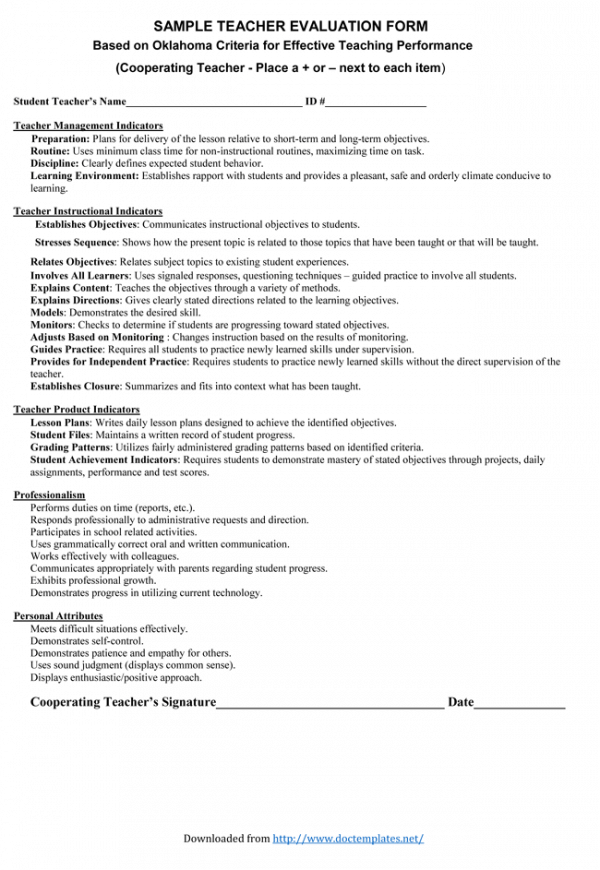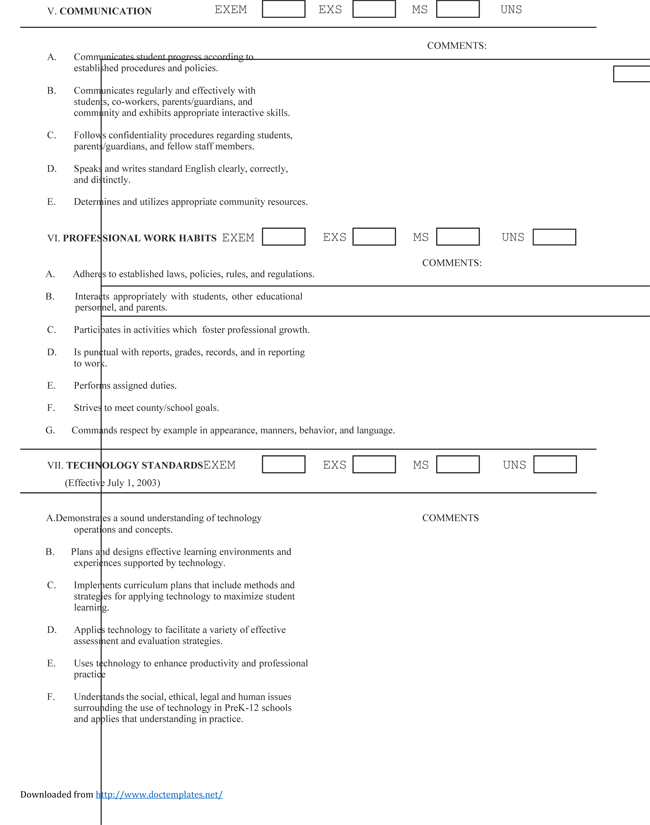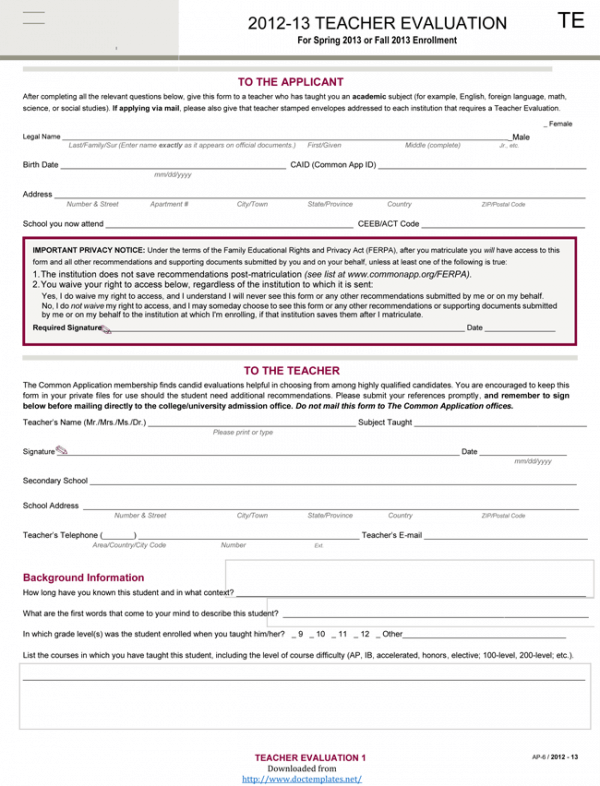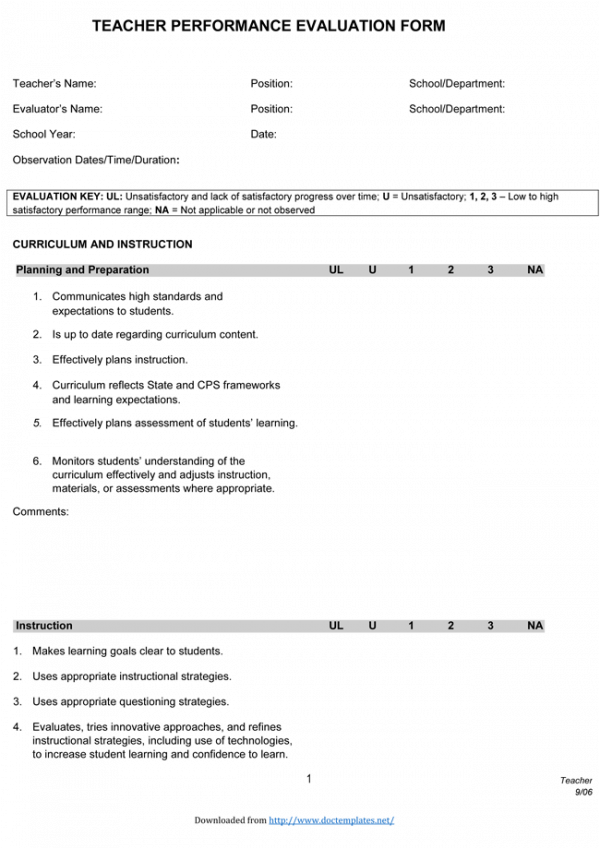In any kind of learning environment, effective teachers contribute a lot when it comes to students’ achievement. Therefore, most schools and learning institutions tend to equip their teaching staff with all the necessities in order to provide their learners with quality education. But how do you ensure the teacher delivers quality education in the classroom as expected? Or, how do you ensure the education system is better designed to impact positively on the learners? Well, the simple answer lies in teacher evaluation.
Teacher evaluation is a process that allows students, parents, and stakeholders to provide feedback on teacher’s conduct. This feedback is used to determine the quality of teaching by assessing their in-class performance. This process is conducted through a teacher evaluation form. Some typical categories that a teacher evaluation form covers include teaching style, goals set for students’ improvement, and how often the teacher met these goals. Other valuable points might be average class size, student attendance rate, the discipline of the students, engagement with students, and how often they met with parents on students’ progress. However, this information will vary from one district to another. These categories are used as criteria for assessment. Evaluation forms are a time-saving, best-practice HR tool that can help any academic institution measure the effectiveness and success of their teachers. Teacher evaluations are conducted by principals, district administrators, and superintendents.
This article will serve to analyze a teacher evaluation form to assess teacher performance and effectiveness.
What is Teacher Evaluation?
Teacher evaluation can be defined as a process of assessing and rating the teaching effectiveness and efficiency of learners. In the contemporary world, teaching evaluation has become a common procedure in most educational institutions. The teacher evaluation usually aims at improving learning experience among students. On the flip side, teacher evaluation also helps teachers to realize faster and effective professional growth in their teaching careers. Usually, the evaluation can be done either by a college/school administration or any other external professional body. The process is not only critical but also useful and productive. For instance, it helps provide feedback that aids in the school’s decision making.
How Does a Teacher Evaluation Form Work?
Unlike the traditional Teacher Evaluation that majorly focused on classroom assessment, modern evaluations are more complex and effective. In other words, there are several factors considered when conducting the modern Teacher Evaluation. Other than being a periodic practice, Teacher Evaluation use charlotte Danielson’s framework of teaching to realize its purpose. However, it’s important to note that the mode of evaluation varies from states and districts.
Traditionally, school administrators could test the score of students to determine the effectiveness and efficiency of teachers. However, this method of Teacher Evaluation was found to be ineffective due to a number of reasons. The principles found it difficult to rate their teachers accurately due to the strong bonds and personal relationships between them. This called for a more sophisticated Teacher Evaluation approach that involves the use of statistical techniques. The following are some of the new models used to conduct meaningful Teacher Evaluation.
Benefits of Teacher Evaluation
Teacher evaluation is a vital component of effective learning. In states or countries, you’ll find the process is governed by legal rules just to maintain its efficacy. Therefore, the following are some of the benefits associated with teacher evaluation:
Improves teachers professionalism
After teachers are evaluated, they are often given feedback from time to time. This feedbacks reassures them of their past performance, as well as their strengths and weaknesses. As such, this provides them with the opportunity to learn from their weaknesses and to improve on them for the future good. Regular updates of a teacher’s performance can make them improve in their service delivery hence professional growth.
Helps maintain teacher’s records
Carrying out a regular teacher evaluation helps maintain a teacher’s record. This is because the teachers are made aware of their weaknesses each time the assessment feedbacks are given. Therefore, they will constantly work on improving their teaching standards.
Helps spot unproductivity or low performance
Since teachers are evaluated on various criteria, the evaluators are always in a better position of highlighting any unproductivity or low performance by teachers. Therefore, the school principals, alongside other senior staff, can decide to let go of such underperformers and replace them with effective and efficient ones.
Helps in making awards or promotional initiatives
The information received from teacher evaluations can be useful when making critical decisions within a school or college. For instance, the school/college administration can use the evaluation feedbacks to perform promotion or issue out rewards.
Helps maintain job descriptions
If teacher evaluation is done regularly, it helps the administration in easier maintenance of job descriptions as well as faculty members.
Provides necessary facility
Through regular teacher evaluations, the administration becomes aware of the available resources and learning facilities. At the same time, the administration is made to provide additional facilities in places where one lacks so as to facilitate the quality provision of education.
When Do You Need a Form?
The use of teacher evaluation forms helps increase the number of efficient teachers in schools, leading to improved, more effective results from the students. Therefore, to achieve this, academic institutions will require the evaluations when assessing the following:
For performance evaluation
Teacher evaluations are done to measure the performance of teachers primarily. However, the measure of academic excellence in schools is the students’ performance. The student’s performance is thus often a reflection of the effectiveness of a teacher’s performance. Thus, evaluation forms gauge this performance and determine what aspects of the teacher’s teaching strategy make it effective. This can be determined by measuring the results a teacher or group of teachers achieves and how they perform compared with other teachers in the district. In some cases, annual or semi-annual evaluations occur to address these concerns.
To know the teacher’s motivations
A teacher’s motivation is directly related to how well they fulfil their obligations for the students and the institution. The form is used when an academic institution’s administration wants to know whether or not a teacher is intrinsically motivated for a job or using their position solely for monetary gain. This helps determine how committed a teacher is to their role and the institution. This helps hire and retain teachers committed to the institution’s goals and objectively want to help the students improve their performance.
Other purposes
Teacher evaluations are also conducted to improve and foster growth in teachers. So, the evaluations can measure a teacher’s abilities and contributions when assigning teachers’ positions within the institution. Performance evaluations can help determine whether or not a teacher should be retained in their position or promoted to an administrative position. Unproductive teachers can be given a chance to improve or resign. Performance evaluations are also considered during promotions and appraisals within an academic institution.
Teacher Evaluation Models
Value-added model (VAM)
The Value-added model is a more accurate method of Teacher Evaluation as it filters out baseness. It aims at measuring a specific contribution a teacher makes towards the learning progress of their students. With this, you can always reach an estimate of how much each teacher contributes towards student learning.
Value-Added Model works by comparing the student’s previous results with the current while taking into account the student’s background. With such a comparison at hand, the model can estimate the student’s future results by calculating the average differences between actual and predicted results. If the student scores below the prediction, then the teacher’s approach can be considered ineffective, and the reverse is true.
Teacher observations
In as much as it’s outdated, some individuals still practice this model of Teacher Evaluation. Here, the school administrator’s listens to individual teachers to handle their respective classroom. During the process, the following factors are often considered:
- The type of learning atmosphere necessitated by the teacher
- The learning content prepared by the teacher
- Teaching and learning aids
- Level of engagement
The teacher observation model helps the administrators to be aware of the teaching processes deployed by their staff.
The framework model
The framework of the Teaching Model (FTM) was first developed by Charlotte Danielson in 1996. The model covers the essential responsibilities of teachers, such as how they plan for lessons, how they act in a classroom environment, how they provide instructions to learners, and how they perform their responsibilities. This model helps in providing a better view of teaching methods hence creating room for skill improvement.
Marzano art and science of the teaching model
This teaching evaluation model was developed in 2017. The model aims at assessing four different teaching competencies, such as standard-based planning, learning, and their conditions and professional responsibilities. The Marzano model also focuses on the teaching atmosphere and how it makes learning effective. One thing that makes this model unique is that it aims at providing in-person training.
Using Form in a Productive Way
It is vital to strategize a practical use when utilizing teacher evaluation forms. This will help provide the most fruitful results from these evaluations and, in turn, develop a more effective educational system. Try implementing the following practices to get the most out of the teacher evaluation form.
Go beyond observations
It’s a good idea to observe or even see the teacher in action as they teach, but this is not the only way you can use the evaluation form. The effectiveness of a teacher’s performance can be measured through multiple metrics. So, evaluate more than one factor. In addition, try to pick up other factors than what the teacher is doing. Note things like enthusiasm, students’ contribution, level of interaction, the class atmosphere with the teacher present and absent and other factors that illustrate positives in the classroom.
Involve all teachers
Teaching is a field that is highly dependent on teamwork. Ensure that your teachers are well-aware of the purpose and goal of teacher evaluation form. Teacher evaluation should be a collaborative process that obtains feedback from all teachers within the academic institution. Allow the teachers to raise their pain points and educate them on the need for teacher evaluations. Let them know teacher evaluation forms are meant to give feedback for constructive criticism after each evaluation. This makes these evaluations more inclusive, increases teachers’ confidence in being evaluated, and motivates them to do better.
Train your teachers to help them do better
After completing the teacher evaluation, the use of the forms does not end there. You should review the teacher’s performance, highlight the significant points that need to be addressed and train the teacher on how to improve on these areas. You can educate them on how to handle current and probable hurdles, best practices in teaching, and specific actions they can take to make improvements. Feedback should be honest and direct and focus on areas where most improvements are needed.
Who can Use a Teacher Evaluation Form?
When it comes to evaluating a teacher, many factors have to be taken into consideration. Therefore, different parties often have to contribute to the assessment. Consequently, students, teachers, or the institution’s management can use teacher evaluation forms to evaluate teachers’ performance from different perspectives. The evaluation forms are used by these parties as follows:
Students
The student’s feedback can be helpful when assessing a teacher’s performance because they have direct in-person interactions with teachers. Students are often concerned with how much their teachers understand them, how much support they are getting, and what happens in the classroom or school. As a result, students will provide feedback on all these aspects when evaluating a teacher. As the end-consumers of teaching services, students can give informative assessments on teachers’ teaching methods and conduct in the classroom. Students can evaluate teachers through student surveys (online or paper-based) using teacher evaluation forms. The students can provide feedback anonymously to encourage honest answers devoid of fear of victimization by the teachers.
This approach to teacher evaluations has its advantages and disadvantages. With students being the end-consumers of a teacher’s performance, using students to evaluate teachers offers a highly effective approach to determining the effectiveness and efficiency of teaching strategies. It is also beneficial because this type of evaluation is based on raw information from the primary end-consumers. However, the downside to this approach is evaluations by students can be largely subjective, where a student’s attitude and personal preference lead to bias in their opinion. As such, students can fail to be objective in their assessments. Also, students may find it challenging to interpret the evaluation criteria outlined in the teacher evaluation form, which compromises the reliability of the assessment.
Other teachers
Teachers can also be a valuable resource when conducting teacher evaluations. For example, a senior teacher assessing a new teacher or colleague. Often, peer-to-peer evaluations are used to evaluate out-of-classroom conduct. Some of the aspects assessed include worth, ethics, skills, attitude, behaviors, etc. This approach is beneficial in that teachers will provide informed opinions of their peers based on evidence from observations, first-hand experiences, and interactions with the targeted teacher over some time.
This approach produces objective evaluations with valid feedback that can be relied on. It is also known to improve the team spirit among colleagues. However, the disadvantage of using this approach is using their colleagues’ feedback to evaluate the teacher’s performance; their perceptions may be skewed due to their relationship with the actual subject matter of teaching.
Management
Feedback from the management can also be used in determining the overall performance of faculty members. This type of evaluation is conducted by the educational advisory board, the principal/headteacher, staff supervisor, and HR personnel. Ordinarily, this approach is done through an in-person meeting where the teacher is interviewed. Then, their performance is measured based on pre-determined criteria set out on the teacher evaluation forms.
Evaluations by management are considered to be highly objective and thus more reliable. Due to the lack of bias in the opinions and information, this type of evaluation gives a more realistic picture of the teacher’s performance. It thus helps in creating feasible improvement plans for each teacher. On the other hand, teacher evaluations by management can do more harm than good in a toxic work environment. Some appraisal team members can use this opportunity to avenge colleagues for a dispute. This can result in biased results, which compromise the effectiveness of the entire exercise.
Expected Questions in Teacher Evaluation Form
The questions in a teacher evaluation form can either be open-ended, close-ended, both, or none. The primary purpose of these questions is to collect the required information about the teachers’ performance. Some of the common types of questions in teacher evaluation forms include:
For students
If the teacher evaluation form is to be used by students to assess the teacher’s performance, its questions can be structured as follows:
- Briefly describe the teacher in class.
- Did the teacher attend all classes during the term?
- Yes
- No
How many did he/she miss?
- What methods were used for assessment in between exams?
- Was the subject successfully covered?
- Yes
- No
- What level of mastery in the specific subject does the teacher demonstrate?
- High
- Above average
- Average
- Low
- Insufficient
For other teachers
A peer-to-peer evaluation will have questions such as illustrated below:
- In a few words, describe the teacher?
- Would you consider the teacher to be a team player?
- Yes
- No
- Does the teacher help other teachers?
- Yes
- No
If NO, why?
- Did the teacher complete the curriculum before the end of the term?
- Yes
- No
- How effective would you say the teacher is in performing their duties?
- Highly effective
- Effective
- Needs improvement
- Unsatisfactory
- Not effective
- What is the nature of the relationship between the teacher with other teachers and students?
For management
If the appraisal team or management evaluates the teacher, questions in the form can be formatted as follows:
- Given the opportunity to reteach this classroom, what would you do differently?
- What are your long-term professional goals?
- The current curriculum is more beneficial to the students than the previous one.
- Strongly agree
- Agree
- Neither
- Disagree
- Strongly disagree
- Is there an area that management needs to improve to support teachers?
- Yes
- No
If YES, explain why.
- What instructional materials were used?
- Does the number of students per class affect reachability?
- Yes
- No
Note: The open-ended question facilitates an extensive discussion and enables the evaluator or assessor to explore deeper into a particular topic. This type of question has no fixed answers, and therefore, there is no right or wrong answer. As the name implies, close-ended questions have multiple fixed answers. These types of questions include a selection of responses, and the respondents are required to pick one or more options from these fixed choices.
Free Forms
Conclusion
A well-constructed teacher evaluation form will provide helpful feedback to the teacher and the school’s management. The feedback can help identify areas for improvement, can be used to assess their performance, and to inform the reasons for any given outcome – in and out of class. It is crucial that in a good teacher evaluation form, all comments are entirely anonymous, such that no one should know who wrote what comments. Each district or academic institution can have its teacher evaluation form based on organizational goals. Teacher evaluation forms are the most common resource for obtaining constructive feedback about other people’s teaching qualities.



